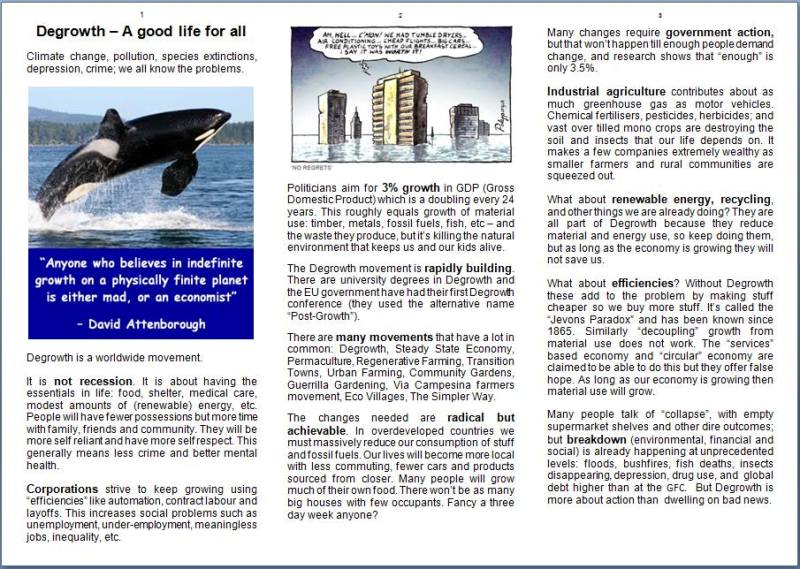File:DeGrowth basics.jpg
DeGrowth_basics.jpg (800 × 569 pixels, file size: 120 KB, MIME type: image/jpeg)
DeGrowth
Also known as Post-growth, Decroissance, Postwachstum, Zero-cost Politics, Doughnut Economics
Limits-to-growth
Ecological economics
○
Compulsive Buying / Rampant Consumerism
○
Affluenza
······························································
Perils of 'short-termism'
Our inability to look beyond 'more-is-better'
The 22nd Century: Get Ready, It's Not So Far Away As You Might Think It Is
All the decisions we make, for better and worse, will be theirs to live with.
Modern society is suffering from “temporal exhaustion”, the sociologist Elise Boulding once said. “If one is mentally out of breath all the time from dealing with the present, there is no energy left for imagining the future...” We can only guess her reaction to the relentless, Twitter-fuelled politics of 2019. No wonder wicked problems like climate change or inequality feel so hard to tackle right now.
That's why researchers, artists, technologists and philosophers are converging on the idea that short-termism may be the greatest threat our species is facing this century.
○
Wrapping Our Minds Around the Big Picture
It's Time for a Big Change
• https://mahb.stanford.edu/welcome/
Foresight intelligence: the ability to implement behavioral, institutional and cultural changes necessary for future generations to live peaceful productive lives. The MAHB envisions a future that embodies two basic principles— all forms of life are essential and interdependent; and, economic underpinnings, social norms, and individual behavior are all part of a single system operating within the bounded biosphere.
What happens when foresight intelligence meets the best of global civil society? Quite simply, we can reduce interconnected complex problems resulting from interactions within and between what can be thought of as two gigantic complex adaptive systems: the biosphere system and the human socio-economic system. These problems include: climate disruption, loss of biodiversity (and thus ecosystem services), land-use change and resulting degradation, global toxification, ocean acidification, decay of the epidemiological environment, an economic system based on growth, pressure from increasing population, and resource wars (which could go nuclear). The manifestation of these interactions is often referred to as “the human predicament.” With foresight intelligence, we can reduce the threats inherent in the human predicament.
This is the Millennium Alliance for Humanity and Biosphere (MAHB)
The Human Ecological Predicament
• https://mahb.stanford.edu/blog/human-eco-predicament
Humanity is on a precariously unbalanced path
By William Rees
(Reprint courtesy of CC BY-ND 2.0)
Techno-industrial society is in dangerous ecological overshoot—the human ecological footprint is at least 60% larger than the planet can support sustainably (Wackernagel et al. 2002; Rees 2013; WWF 2016). The global economy is using even renewable and replenishable resources faster than ecosystems can regenerate and filling waste sinks beyond nature’s capacity to assimilate (Steffen et al. 2007; Rockström et al. 2009; Barnosky et al. 2012). (Even climate change is a waste management problem—carbon dioxide is the single greatest waste by weight of industrial economies.) Despite the accumulating evidence of impending crisis, the world community seems incapable of responding effectively. This situation is clearly unsustainable and, if present trends continue, will likely lead in this century to runaway climate change, the collapse of major biophysical systems, global strife and therefore diminished prospects for continued civilized existence (Tainter 1987; Diamond 2005; Turner 2014; Motesharrei et al. 2014).
The proximate drivers are excess economic production/consumption and over-population—human impact on the ecosphere is a product of population multiplied by average per capita consumption—exacerbated by an increasingly global compound myth of perpetual economic growth propelled by continuous technological progress (Victor 2008; Rees 2013). While there is evidence of some ‘decoupling’ of economic production from nature, this is often an artifact of faulty accounting and trade (e.g., wealthy countries are ‘off-shoring’ their ecological impacts onto poorer countries). Overall, economic throughput (energy and material consumption and waste production) is increasing with population and GDP growth (Wiedmann et al 2013; Giljum et al. 2014). Consequently, carbon dioxide is accumulating at an accelerating rate in the atmosphere (NOAA 2017) and the years 2014, 2015 and 2016 sequentially shared the distinction of being the warmest years in the instrumental record (Hansen et al. 2017).
There is widespread general support for the notion of ‘clean production and consumption’ but in present circumstances, this must soon translate into less production and consumption by fewer people (Rees 2014). It complicates matters that modern society remains highly dependent on abundant cheap energy still mostly supplied by carbon-based fuels. Despite rapid technological advances and falling costs, it is still not clear that renewable energy alternatives, including wind and photovoltaic electricity, can replace fossil fuels in such major uses as transportation and space/water heating in the foreseeable future. Nevertheless, in the absence of effective carbon sequestration technologies, reducing fossil fuel use remains essential to avoiding catastrophic climate change. Resolving this energy-climate conundrum will require major conservation efforts, the prioritizing of essential non-substitutable uses of fossil fuels and the banning of frivolous ones.
At the same time, this is a world of chronic gross social inequity which greatly erodes population health and social cohesion (Wilkinson and Pickett 2010). According to Oxfam (2017), the world’s richest eight billionaires possess the same wealth as the poorest 50% of the human family. More generally, the richest quintile of humanity takes home about 70% of global income compared to just 2% by the poorest fifth of the population (Ortiz and Cummins 2011).
Higher incomes enable the citizens of high income countries to consume, on average, several times their equitable share of global biocapacity while denizens of poor countries are unable to claim a fair allocation of Earth’s bounty (WWF 2016). This situation is egregiously unjust, socially destabilizing and ecologically precarious.
The major social implications of these realities should be self-evident. In a rational world, the global community (e.g., the United Nations, the World Bank/IMF) would cease promoting material growth as the primary solution to both north-south inequity and chronic poverty within nations. On a finite planet already in overshoot it is not biophysically possible to raise the material standards of the poor to those of the rich sustainably—i.e., without destroying the ecosphere, undermining life-support functions and precipitating the collapse of global society. The reasoning is simple. Because they facilitate growth and (over)consumption, globalization and trade have enabled many densely-populated high-income countries (e.g., most Western European nations and Japan) to greatly exceed their domestic carrying capacities. These nations live mostly on imported biocapacity—they are running ‘ecological deficits’ with other nations and the global commons (Rees 2013, WWF 2016). Not every country can be a net importer of bio-resources, so the development path worn by so-called ‘First-world nations’ cannot be followed by developing countries. (Note that the bloated eco-footprints of many high-income countries make them effectively more over-populated than are poorer countries with nominally higher population densities.) In particular, it is irresponsible for the governments of high-income countries to treat economic growth as the panacea for all that ails them.
The evidence argues instead that the world community should cooperate on redistribution, on devising methods to share the benefits of development more equitably. (Unsustainability is a collective problem that requires collective solutions.) Contrary to politicians’ assertions, there is an unavoidable conflict between material economic growth and ‘the environment’. The larger the human enterprise, the more diminished the ecosphere. H. sapiens has competitively displaced countless other species from their habitats and food resources. From only one percent 10,000 years ago, humans and their domestic livestock had grown to comprise over 97% of Earth’s mammalian biomass by 2000 (Smil 2011). This number may be closer to 98.5% in 2017.
The goal should be to enhance the material well-being of developing countries and the poor while simultaneously reducing both aggregate material throughput and world population. Ensuring an economically secure and ecologically stable environment for all requires:
1. that rich nations consume less to free up the ecological space needed for justifiable consumption increases in poorer countries (BCSD 1993; Moore and Rees 2013); and
2. that the world implement a universal population management plan designed to reduce the total human population to a level that can be supported indefinitely at a more-than-satisfactory average material standard. This is what it means to ‘live sustainably within the means of nature’ (Rees 2014).
Fortunately, planned degrowth (Kerschner 2010; Gheorghică 2012) toward a quasi steady-state economy (Daly 1991, 2008) is technically possible (von Weizsäcker et al. 2009), would benefit the poor and could be achieved while improving overall quality of life even in high-income countries (Victor 2008). Considering the human suffering that would be avoided and number of non-human species that would be preserved, it is also a morally compelling strategy.
Obviously, the foregoing diagnosis is anathema to the prevailing growth ethic, the belief that well-being is a linear function of income, and political correctness pertaining to population policy. Many will therefore object on grounds that the foregoing prescription is politically unfeasible and can never be implemented.
They may well be correct. The problem is that what is politically feasible is often ecologically irrelevant. Effective sustainability policy must be consistent with available scientific evidence; ‘alternative facts’ are mere self-delusion. Failure to implement a global sustainability plan that addresses excess consumption and over-population while ensuring greater social equity may well be fatal to the human prospect.
Indeed, adherence to any variant of the status quo promises a future of uncontrollable climate change, plummeting biodiversity, civil disorder, geopolitical turmoil and resource wars. In the circumstances, opponents of the present prescription have an obligation to propose an alternative plan that similarly promises ecological stability, economic security, social equity and improved population health to future generations.
William E. Rees, PhD, FRSC [email protected] is a professor emeritus at the University of British Columbia and former director of the School of Community and Regional Planning (SCARP) at UBC. Rees originated and co-developed ecological footprint analysis, which is described in the book Our Ecological Footprint: Reducing Human Impact on the Earth.
○
Buddhist Economics
○
File history
Click on a date/time to view the file as it appeared at that time.
| Date/Time | Thumbnail | Dimensions | User | Comment | |
|---|---|---|---|---|---|
| current | 03:16, 9 March 2019 |  | 800 × 569 (120 KB) | Siterunner (talk | contribs) |
You cannot overwrite this file.
File usage
The following 2 pages use this file:

